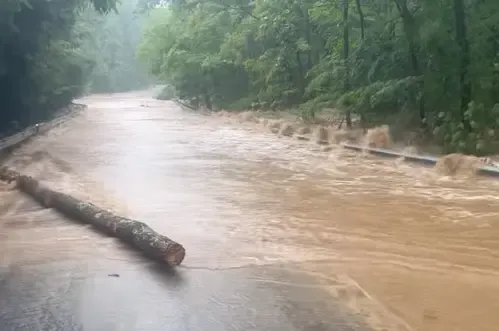Are the 2025 Flash Floods Indicating a Growing Climate Risk in the US?

Synopsis
Key Takeaways
- Flash floods in 2025 have surged, with over 3,600 warnings issued.
- Texas has faced the brunt of these disasters, with significant loss of life.
- Climate change is intensifying rainfall and increasing flood severity.
- Experts call for stronger building regulations and updated flood maps.
- The recent floods may indicate a trend towards more frequent extreme weather events.
Sacramento, United States, July 26 (NationPress) This summer has brought a wave of unexpected and lethal floods throughout the United States, overwhelming emergency response systems and highlighting the scientific factors that contribute to the heightened danger of today's storms, according to experts.
The US National Weather Service reported on Saturday that over 3,600 flash flood warnings were issued in 2025, a rate that may exceed the average annual total of approximately 4,000, as heavy rains persisted into late July.
Texas has been significantly impacted. On July 4, torrents of water surged through the Guadalupe River valley, resulting in at least 135 fatalities statewide. Kerr County alone reported 107 deaths, including many children at a summer camp, as noted by local officials mentioned in the environmental news outlet Grist. Water gauges in nearby Kerrville recorded rises exceeding 11.3 meters within 45 minutes, overwhelming rescuers, according to Xinhua news agency.
Experts indicated that warmer oceans have released unprecedented amounts of water vapor into the atmosphere this year, while a weak jet stream has allowed storm clouds to remain over specific regions.
This combination has rendered the thunderstorms of 2025 particularly intense, as noted by Jeffrey Basara, a meteorology professor at the University of Massachusetts Lowell, in his piece for The Conversation on Friday. He pointed out that areas east of the Rocky Mountains received at least 50% more precipitation than normal between mid-April and mid-July.
Surface conditions exacerbate the risks, according to the expert, who noted that saturated soils, steep landscapes, and expansive pavement funnel water into creeks and streets with alarming speed. The July 4 deluge targeted the river's headwaters, which Basara described as the worst possible configuration, unleashing a torrent downstream.
Climate change is further amplifying these effects. Recent studies suggest that the floods in the Texas Hill Country were approximately 7% more severe due to elevated temperatures intensifying rainfall, as stated by Annalisa Peace, executive director of the Greater Edwards Aquifer Alliance, in the San Antonio Express News on Saturday.
Basara cautioned that this trend is expected to worsen, referencing climate models that predict increasingly intense downpours in the US as temperatures rise, heightening the risk of future flash flood catastrophes.
Currently, millions of homes across the US are situated in flood-prone areas. Grist reported that 7.9 million structures are located within regions designated by the US Federal Emergency Management Agency as having at least a 1% annual risk of flooding.
Experts have called for more robust building regulations, updated flood maps, and the implementation of green infrastructure.
With rising ocean temperatures and continued development into floodplains, scientists have warned that the 'summer of flash flooding' may not just be an anomaly but rather a glimpse into what the future holds for the United States and, by extension, a world facing a wetter, warmer climate.










